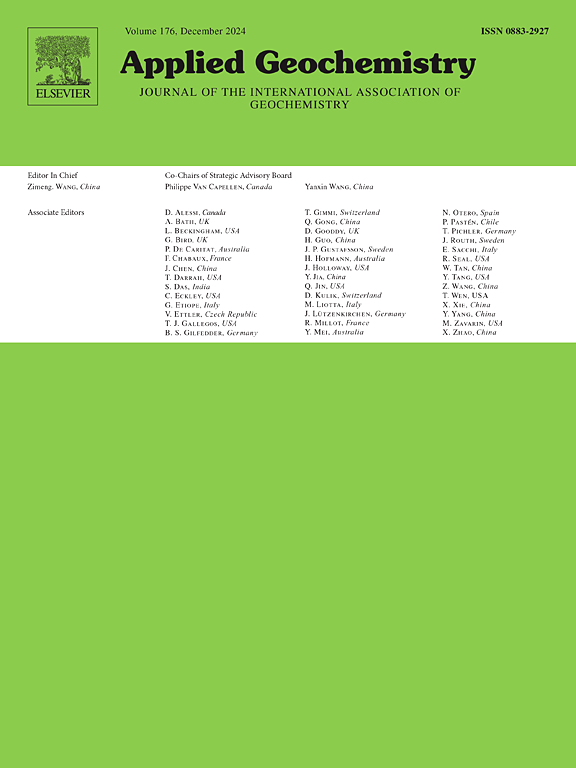Sources and fates of NO3− and PO43− in an alluvial plain wetland - Insights from the Auzon oxbow and the alluvial aquifer of the Allier (Auvergne, France)
IF 3.1
3区 地球科学
Q1 GEOCHEMISTRY & GEOPHYSICS
引用次数: 0
Abstract
The continental hydrosystems of wetlands play fundamental socio-economic and environmental roles in all aquatic environments. These ecosystems, when located at the interface between surface and groundwater, such as oxbows, are of crucial importance in regulating water and nutrient flows. They help control water quality and provide ideal habitats for often fragile species. The transfer of contaminants into the different compartments of the groundwater-wetland-river continuum is difficult to characterize because they are most often of different types and origins within the same hydrosystem. The objective of this study is to characterize water quality and water exchange using a multi-tracer approach combining monthly hydrochemical monitoring, isotopic characterization of NO3− molecules (δ18ONO3 and δ15NNO3) and concentration of chemical micropollutant particles. This methodology is applied to a fluvial annex of the Allier River, the Auzon oxbow hydrosystem, subject to moderate environmental and anthropogenic pressure (low level of industrialization and urbanization, mixed conventional farming). Nitrate (NO3−) and phosphate (PO43−) concentrations do not behave in the same way over time: NO3− has a seasonal dynamic, whereas phosphates are disconnected from the hydrological regime. Some subsystems of the Auzon oxbow are undergoing denitrification, demonstrating the importance of preserving these environments for their nutrient regulation potential. As for chemical micropollutants and PO43−, the low overall concentration of these two contaminants, coupled with the high dilution potential of the Auzon oxbow hydrosystem, means that average concentrations remain within acceptable standards for surface waters. Based on these results, the Auzon hydrosystem is maintaining good ecological quality despite nutrient flows from multiple sources. The multi-tracer approach used in this study demonstrates its effectiveness in determining the origin of nutrients, and it could be applied to other studies in contexts where environmental and societal pressures are significantly higher.
冲积平原湿地NO3−和PO43−的来源和归宿——来自奥宗牛沟和阿利埃河冲积含水层的见解(奥弗涅,法国)
大陆湿地水系在所有水生环境中发挥着基本的社会经济和环境作用。这些生态系统位于地表水和地下水的界面,如牛轭,在调节水和养分流动方面至关重要。它们有助于控制水质,并为脆弱的物种提供理想的栖息地。污染物进入地下水-湿地-河流连续体的不同区室的转移是难以描述的,因为它们通常在同一水文系统中具有不同的类型和来源。本研究的目的是利用多示踪方法,结合每月的水化学监测、NO3−分子(δ18ONO3和δ15NNO3)的同位素表征和化学微污染物颗粒的浓度,来表征水质和水交换。该方法适用于阿列河的河流附件,即Auzon牛轭水系,受到适度的环境和人为压力(低水平的工业化和城市化,混合传统农业)。硝酸盐(NO3−)和磷酸盐(PO43−)浓度随时间的变化并不相同:NO3−具有季节性动态,而磷酸盐则与水文制度脱节。Auzon牛轭的一些子系统正在经历反硝化,这表明保护这些环境对其营养调节潜力的重要性。至于化学微污染物和PO43−,这两种污染物的总浓度较低,加上Auzon牛牛水系统的高稀释潜力,意味着平均浓度仍在地表水可接受的标准范围内。基于这些结果,尽管有多种来源的养分流动,Auzon水文系统仍保持良好的生态质量。本研究中使用的多示踪剂方法证明了其在确定营养素来源方面的有效性,并且可以应用于环境和社会压力明显较高的其他研究中。
本文章由计算机程序翻译,如有差异,请以英文原文为准。
求助全文
约1分钟内获得全文
求助全文
来源期刊

Applied Geochemistry
地学-地球化学与地球物理
CiteScore
6.10
自引率
8.80%
发文量
272
审稿时长
65 days
期刊介绍:
Applied Geochemistry is an international journal devoted to publication of original research papers, rapid research communications and selected review papers in geochemistry and urban geochemistry which have some practical application to an aspect of human endeavour, such as the preservation of the environment, health, waste disposal and the search for resources. Papers on applications of inorganic, organic and isotope geochemistry and geochemical processes are therefore welcome provided they meet the main criterion. Spatial and temporal monitoring case studies are only of interest to our international readership if they present new ideas of broad application.
Topics covered include: (1) Environmental geochemistry (including natural and anthropogenic aspects, and protection and remediation strategies); (2) Hydrogeochemistry (surface and groundwater); (3) Medical (urban) geochemistry; (4) The search for energy resources (in particular unconventional oil and gas or emerging metal resources); (5) Energy exploitation (in particular geothermal energy and CCS); (6) Upgrading of energy and mineral resources where there is a direct geochemical application; and (7) Waste disposal, including nuclear waste disposal.
 求助内容:
求助内容: 应助结果提醒方式:
应助结果提醒方式:


